Do you find that sewing polyester fabric presents unique challenges and rewards? This synthetic material offers durability and wrinkle resistance. But it requires specific techniques to handle its slippery nature and heat sensitivity.
From selecting the right needle size to adjusting stitch length, each step demands careful attention to detail. Master these fundamentals, and you'll reveal the potential to create professional-looking garments.
Key Takeaways
- Choose the right needle with polyester thread. Install a walking foot to prevent fabric slipping during sewing.
- Set the stitch length to 2.5mm for straight stitches. Or use a small zigzag stitch for stretchy polyester fabrics.
- Pre-wash polyester fabric in cold water. Lay it flat to prevent future shrinkage and ensure accurate cutting.
- Finish seams with zigzag stitches or a serger to prevent fraying. Consider using fabric sealant on raw edges.
- Manage slippery fabric by using fabric clips instead of pins. Sew at a slow speed for better control.
Understanding Polyester Fabric
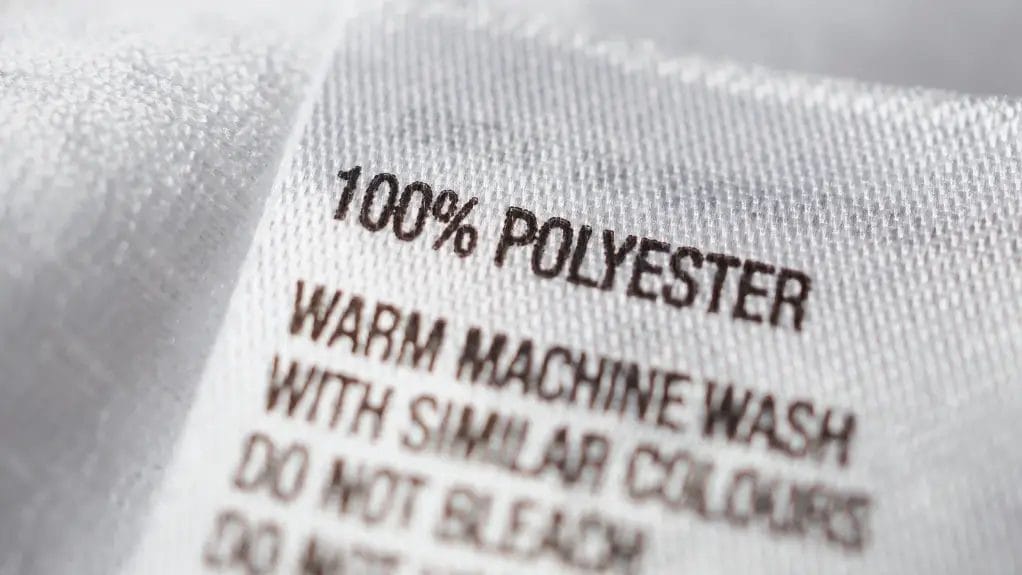
Polyester is a widely used synthetic material that combines durability with wrinkle resistance. This makes it perfect for everyday garments and home décor projects.
Characteristics of Polyester
The versatile nature of polyester fabric makes it a powerhouse in modern sewing projects. As a synthetic fabric, it offers exceptional durability. You'll appreciate this in both clothing and home decor items.
Polyester resists wrinkles and maintains its shape. This makes it perfect for garments that look crisp throughout the day.
When working with polyester, you'll notice its silk-like texture and excellent color retention.
It's less breathable than natural fibers. But you'll benefit from its moisture-wicking properties and resistance to shrinking.
The fabric's lightweight yet strong characteristics make it ideal for long-lasting pieces in your wardrobe.
Types of Polyester
As you explore polyester fabrics, you'll find many types that serve various sewing needs.
- Microfiber polyester offers water-repellent properties perfect for activewear.
- Stretch polyester blends incorporate spandex for flexible garments like leggings.
- The lustrous finish of polyester satin is ideal for formal wear and evening dresses.
- For structured garments, consider woven polyester varieties such as taffeta and poplin. They provide excellent durability and resist wrinkles.
- Microfleece delivers warmth and comfort for casual wear.
- Crepe adds texture to flowing garments.
Each type requires specific handling and sewing techniques for peak results.
Preparing to Sew with Polyester Fabric

Gather essential tools before starting your polyester sewing project. Additionally, pre-wash it in cold water to prevent future shrinkage.
Choose the Right Tools
Selecting the proper tools and materials is a critical first step for successful polyester sewing projects.
- First, you'll need a suitable needle for polyester. Choose a Microtex for woven fabrics or a ballpoint for stretchy polyester.
- Next, choose polyester thread that matches your fabric. This will prevent puckering and guarantee durable seams.
- Equip yourself with a walking foot attachment to control fabric slippage during sewing.
- Sharp scissors designed for synthetic materials will give you clean, precise cuts.
- Keep specialized pins handy to secure your fabric without leaving marks.
These tools work together to help you achieve professional-looking results.
Pre-wash and Prepare the Fabric
Proper fabric preparation will determine the quality of your final results.
Pre-wash your fabric in cold water. This will prevent future shrinkage and maintain the fabric's integrity.
Once your fabric is clean and dry, lay it flat on your work surface and align it carefully with the grain. This step is essential for achieving accurate measurements and preventing distortion.
When you're ready to cut the fabric, use sharp scissors for precise edges. Test your cutting and sewing techniques on scraps first. You can also consider applying fabric sealant to raw edges to minimize fraying.
Sewing Polyester Fabric by Hand and Machine
Whether you use a sewing machine or hand-sew polyester, you need to learn specific techniques to handle this fabric well.
Sewing Polyester With a Sewing Machine
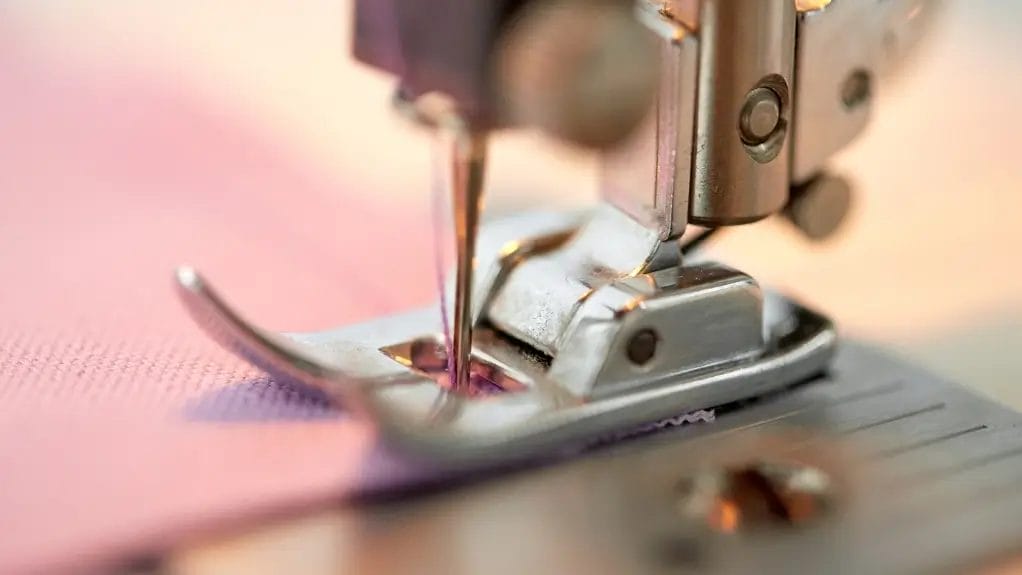
Mastering polyester on your sewing machine requires specific techniques for professional results.
- Install a sharp Microtex or stretch sewing machine needle that matches your fabric weight.
- Set your sewing machine to a medium straight stitch at a 2.5mm length.
- Use a small zigzag stitch for stretchy polyester.
- Attach a walking foot to prevent fabric slipping and guarantee even feeding.
- Adjust your machine's tension carefully, testing on scraps first.
- To finish seams cleanly, use a zigzag stitch or serger along the edges.
- Remember to sew at a steady, controlled pace to maintain stitch consistency.
Sewing Polyester By Hand
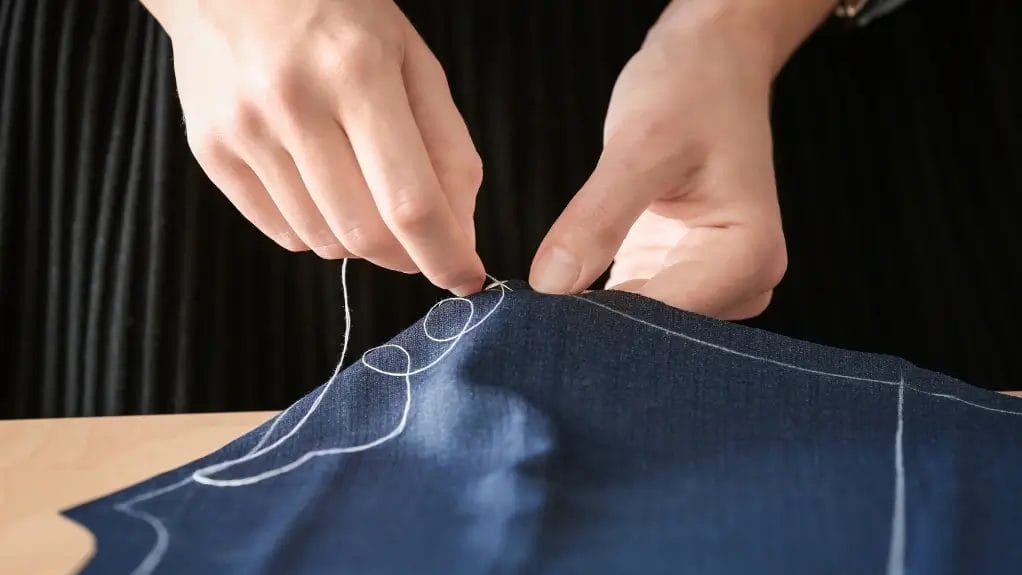
Hand-sewing polyester also requires specific techniques to achieve professional results.
- Select a sharp Microtex needle and matching polyester thread to prevent snags and breakage.
- For strong seams, use a backstitch, working from right to left with evenly spaced stitches.
- When you need invisible hems, employ a slip stitch by catching small sections of fabric.
- For gathering or temporary placement, a running stitch works well.
- Keep your stitches consistent in size and tension to avoid puckering. You can space them about 1/8 inch apart for durability.
- Pull the thread gently to maintain even pressure throughout your work.
Unique Challenges When Sewing Polyester
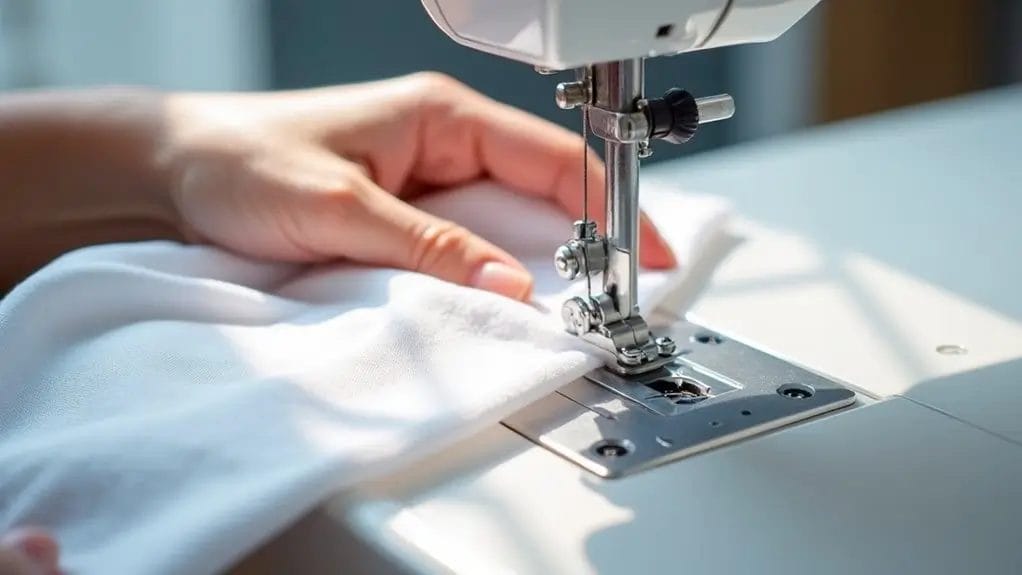
When working with polyester fabric, you'll need to tackle several unique challenges.
Manage Static Cling and Fabric Movement
Polyester inherits a natural tendency to develop static cling. So you'll need specific strategies to manage both the static and the fabric movement.
- To control static cling, apply an anti-static spray or fabric softener before cutting your fabric.
- When handling the material, use pattern weights instead of pins. They can keep pieces stable during cutting.
- For smoother sewing, install a walking foot and adjust the presser foot pressure.
- Maintain steady, controlled movements while sewing to prevent fabric shifting.
- If you have ongoing static issues, sew more slowly and use a small humidifier. This will maintain humidity in your work area.
Deal With Slippery Surfaces
Slippery polyester surfaces present their own set of challenges at your sewing machine. You'll need specific techniques to achieve professional results.
- To combat fabric shifting, install a walking foot on your machine. It'll help feed both layers evenly through the feed dogs.
- Secure your seams with temporary spray adhesive or fabric clips instead of pins.
- When cutting, use sharp scissors and pattern weights to prevent distortion.
- Slow down your sewing speed. Consider using a small zigzag stitch, especially on stretchy polyester.
Troubleshoot Puckering and Stretching
Polyester fabric offers durability and versatility. But puckering and stretching can frustrate even experienced sewists.
- To combat these issues, use polyester thread that matches your fabric's stretch properties.
- Set your stitch length to 2.5mm. This will reduce tension and prevent seam distortion.
- Install a walking foot to feed your fabric evenly through the machine. Reduce your presser foot pressure to allow smoother fabric movement.
- For lightweight or stretchy polyester, apply interfacing or stay tape along seam lines. These stabilizers prevent waviness and maintain your garment's shape.
Deal With Fraying Edges
When working with polyester, deal with fraying edges right away to ensure your garment lasts.
- Start by cutting your fabric with pinking shears. This will create a zigzag pattern that naturally resists unraveling.
- Apply a zigzag stitch along raw edges or use French seams for a professional finish.
- For extra protection, especially in high-wear areas, apply a fabric sealant.
- When working with particularly delicate polyester, use a lightweight stabilizer to maintain edge integrity.
- Remember to inspect your seams regularly. Reinforce any areas showing signs of fraying.
Conclusion
Mastering polyester fabric sewing isn't as challenging as it first appears. You're well-equipped to tackle any polyester project with the right tools, proper preparation, and appropriate techniques.
Remember to use sharp Microtex needles. Adjust your stitch length and finish seams properly. By following these guidelines and practicing consistently, you'll create professional-looking garments.
Learn more sewing tips on the Longan Craft Blog, and dive into the fabric world with Longan Craft!
FAQs
What Is the Best Stitch for Polyester Fabric?
Use a medium-length straight stitch (2.5mm) for regular seams. When working with stretchy polyester, switch to a small zigzag stitch (2.5mm length, 2mm width) instead.
Do You Need a Special Needle to Sew Polyester?
You don't need a special needle. But you'll get the best results using a universal or Microtex needle. For thin polyester, use size 11/75. For thicker polyester, choose 80/12. Stretch needles work for knits.
What Is the Best Sewing Machine Tension for Polyester?
Set your machine's tension between 4 and 5 for standard polyester. If you notice puckering, lower it slightly. Test on scrap fabric first and adjust until your stitches look balanced.

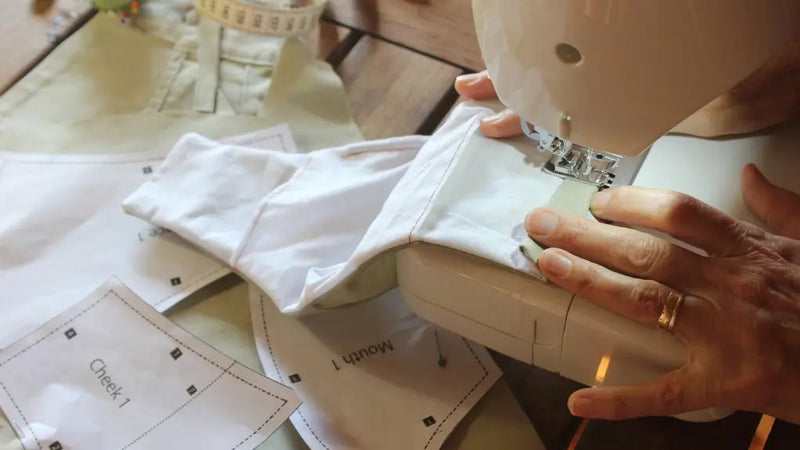
0 comments